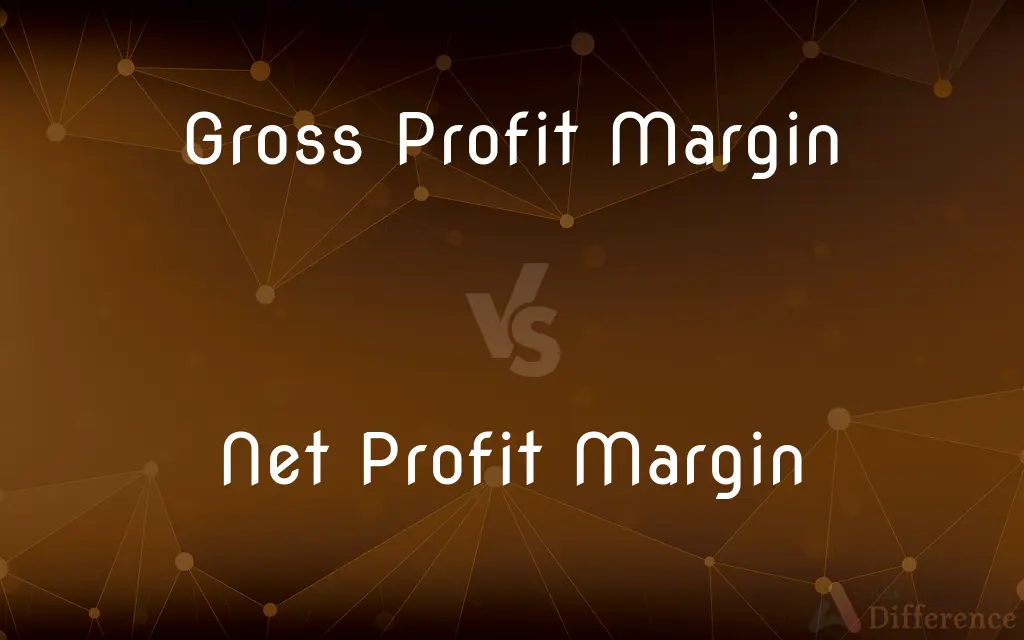Gross Profit Margin vs. Net Profit Margin — What's the Difference?
By Tayyaba Rehman — Published on November 21, 2023
Gross Profit Margin indicates profitability after considering cost of goods sold, while Net Profit Margin takes into account all expenses, yielding net income.

Difference Between Gross Profit Margin and Net Profit Margin
Table of Contents
ADVERTISEMENT
Key Differences
Gross Profit Margin and Net Profit Margin are vital metrics in assessing a company's financial health. Gross Profit Margin illustrates the percentage of revenue that surpasses the cost of goods sold (COGS). In essence, it measures how efficiently a business produces its goods. On the contrary, Net Profit Margin signifies the percentage of revenue remaining after all business expenses, including operating and non-operating costs, are deducted. It gives a more comprehensive view of a company's profitability.
Gross Profit Margin focuses on the direct costs associated with producing goods or services. By considering only the cost of goods sold and revenue, the Gross Profit Margin gives insights into the basic profitability of a company's core operations. Net Profit Margin, on the other hand, factors in everything—from operating expenses like salaries and rent to interest and tax payments. It offers a wider perspective on how much of every sales dollar translates into profit.
While Gross Profit Margin offers a preliminary insight into production and sales efficiency, Net Profit Margin dives deeper, showing how efficiently the company operates as a whole. If a company has a high Gross Profit Margin but a significantly lower Net Profit Margin, it may indicate high overhead or other operating costs. Conversely, similarities between Gross Profit Margin and Net Profit Margin might point to well-controlled operating expenses.
In sum, while Gross Profit Margin and Net Profit Margin both speak to profitability, they offer different levels of insight. Gross Profit Margin revolves around production and sales, whereas Net Profit Margin reflects the overall operational efficiency, considering all expenses.
Comparison Chart
Definition
Revenue percentage surpassing COGS.
Revenue percentage after deducting all business expenses.
ADVERTISEMENT
Costs Considered
Only cost of goods sold (COGS).
All expenses including operating and non-operating costs.
Insight Provided
Production and sales efficiency.
Overall operational efficiency.
Calculation Complexity
Simpler (Revenue - COGS) / Revenue.
More complex, considering all expenses.
Indicative Concerns
Efficiency in production/sales.
Efficiency in managing all operational costs.
Compare with Definitions
Gross Profit Margin
Gross Profit Margin represents sales efficiency.
Their Gross Profit Margin of 40% indicates strong sales strategies.
Net Profit Margin
Net Profit Margin encompasses total profitability.
Their Net Profit Margin of 15% shows sound overall operational efficiency.
Gross Profit Margin
Gross Profit Margin highlights direct costs.
Despite high sales, a low Gross Profit Margin revealed escalating production expenses.
Net Profit Margin
Net Profit Margin factors all expenses.
Despite high gross profits, their Net Profit Margin was low due to rising marketing costs.
Gross Profit Margin
Gross Profit Margin denotes core profitability.
A consistent Gross Profit Margin year-over-year shows stable production costs.
Net Profit Margin
Net Profit Margin deciphers net earnings.
Their declining Net Profit Margin was a sign of increasing non-operational expenses.
Gross Profit Margin
Gross Profit Margin reveals cost of goods dynamics.
Due to sourcing challenges, their Gross Profit Margin decreased by 10%.
Net Profit Margin
Net Profit Margin provides holistic financial insights.
With a Net Profit Margin of 20%, the company demonstrated commendable financial management.
Gross Profit Margin
Gross Profit Margin isolates production costs.
With a Gross Profit Margin of 60%, their manufacturing process is commendably cost-effective.
Net Profit Margin
Net Profit Margin indicates bottom-line earnings.
A climbing Net Profit Margin revealed their ability to manage costs across the board.
Common Curiosities
Can a company have a high Gross Profit Margin but low Net Profit Margin?
Yes, due to high operational or non-operational expenses.
What can a decline in Gross Profit Margin indicate?
It may signal rising production costs or declining sales prices.
How is Gross Profit Margin calculated?
By subtracting COGS from revenue and dividing by revenue.
If a company's Net Profit Margin improves, what does it mean?
The company is effectively managing all its expenses relative to its revenue.
Which margin considers taxes and interest?
Net Profit Margin.
Can two companies with the same Gross Profit Margin have different Net Profit Margins?
Yes, due to differences in operational or other expenses.
Which is more comprehensive: Gross Profit Margin or Net Profit Margin?
Net Profit Margin, as it considers all business expenses.
Which margin only considers cost of goods sold?
Gross Profit Margin.
Why is it important to consider both margins when evaluating a company's financial health?
Gross Profit Margin evaluates production/sales efficiency, while Net Profit Margin assesses overall profitability.
Which margin provides a comprehensive profitability view?
Net Profit Margin.
Share Your Discovery

Previous Comparison
Volumetric Analysis vs. Titration
Next Comparison
Qatar Airways vs. Turkish AirlinesAuthor Spotlight
Written by
Tayyaba RehmanTayyaba Rehman is a distinguished writer, currently serving as a primary contributor to askdifference.com. As a researcher in semantics and etymology, Tayyaba's passion for the complexity of languages and their distinctions has found a perfect home on the platform. Tayyaba delves into the intricacies of language, distinguishing between commonly confused words and phrases, thereby providing clarity for readers worldwide.
















































